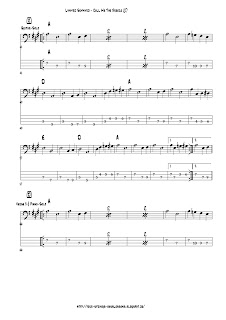Basilio from Italy asked me if I could translate a prior post regarding the dorian mode into english and finally I got that managed. So here's my little workshop about the dorian mode in english:
The dorian scale is derived from the major scale:
When you rearrange the notes of a C-major scale starting from the second dregree (“D”) and proceed through it until that same note is reached one octave higher, you’ll be constructing the D-dorian scale.
The d dorian scale contains the same notes as the c-major scale, just in different order.
When you built the diatonic chords on the dorian scale, you’ll find that dorian belongs to the group of minor scales. The first chord (tonic) in D-dorian is D-minor.
In contrast to the aolian(or natural) minor scale the dorian scale has a major chord on the fourth degree (IV; sudominant) and the sixth degree happens to be a whole step above the dominant.
A trademark progression for the dorian scale is alternating between the minor tonic and the major subdominant chord. There are several songs which make use of that progression (i - IV).
We now want to construct the E-dorian scale. As the dorian scale is built on the second degree of a major scale, we go down a whole step from the E and take the D-major scale as a starting point.
Here are the diatonic chords of the E-dorian scale:
The i-Iv-progression in E-dorian consists of the chords E-minor (i, tonic) and A-major (IV, subdominant).
Often this progression is spiced up by adding a few “tension tones” to the plain triads. In our example the tonic will be played as a seventh-chord (Em7) and the subdominant gets the seventh and the “13”(A7/13), which is a sixth played an octave higher.
In the video I show you four different basslines over the i-IV-progression. The notes of the bassline are all derived from the chord-tones of the accompanying chords.
In the transcriptions of the basslines I denoted the function of every note related to the respective chords by using these short cuts:
R = root of the chord
3 = major third
b3 = minor third
5 = fifth
b7 = minor seventh
13 = octave of the sixth (6)
The i-IV-progression in the dorian mode is really a very common progression.
Here are a few examples of songs which use this progression:
Santana - Oye como va (Am - D)
Allman Brothers - In Memory of Elizabeth Reed (Am9 - D)
Billy Cobham - Red Baron (Gm7 - C9)















+-+1.TIF)
+-+2.TIF)
+-+3.TIF)
+-+4.TIF)
+-+5.TIF)
+-+6.TIF)

+-+8.TIF)

.TIF)

.TIF)











.jpg)











